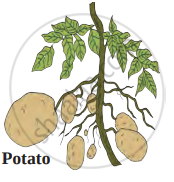Advertisements
Advertisements
Question
How do Dioscorea reproduce vegetatively?
Solution
Vegetative reproduction in stem From Unit 3 of class XI (Vegetative morphology) you are familiar with the structure of various underground stem and sub aerial stem modifications. These include rhizome (Musa paradisiaca, Zingiber officinale, and Curcuma longa); corm (Amorphophallus and Colocasia); tuber (Solanum tuberosum); bulb(Allium cepa and Lillium) runner (Centella Asiatica); stolon (Mentha, and Fragaria); offset (Pistia, and Eichhornia); sucker (Chrysanthemum) and bulbils (Dioscorea and Agave). The axillary buds from the nodes of the rhizome and the eyes of the tuber give rise to new plants.
APPEARS IN
RELATED QUESTIONS
Define vegetative propagation.
What is the modification seen in the Bryophyllum. Explain
List out two sub-aerial stem modifications with examples.
What is layering?
A detached leaf of Bryophyllum produces new plants. How?
Write short notes on approach grafting.
Distinguish mound layering and air layering.
List down the advantages of conventional methods.
Observe the following figure and answer the questions below:


- Which process is shown in figure?
- Define the process.
- Give an example of the process depicted.
Which ability of plants like banana and bryophyllum is exploited by gardeners and farmers for their commercial propagation?
